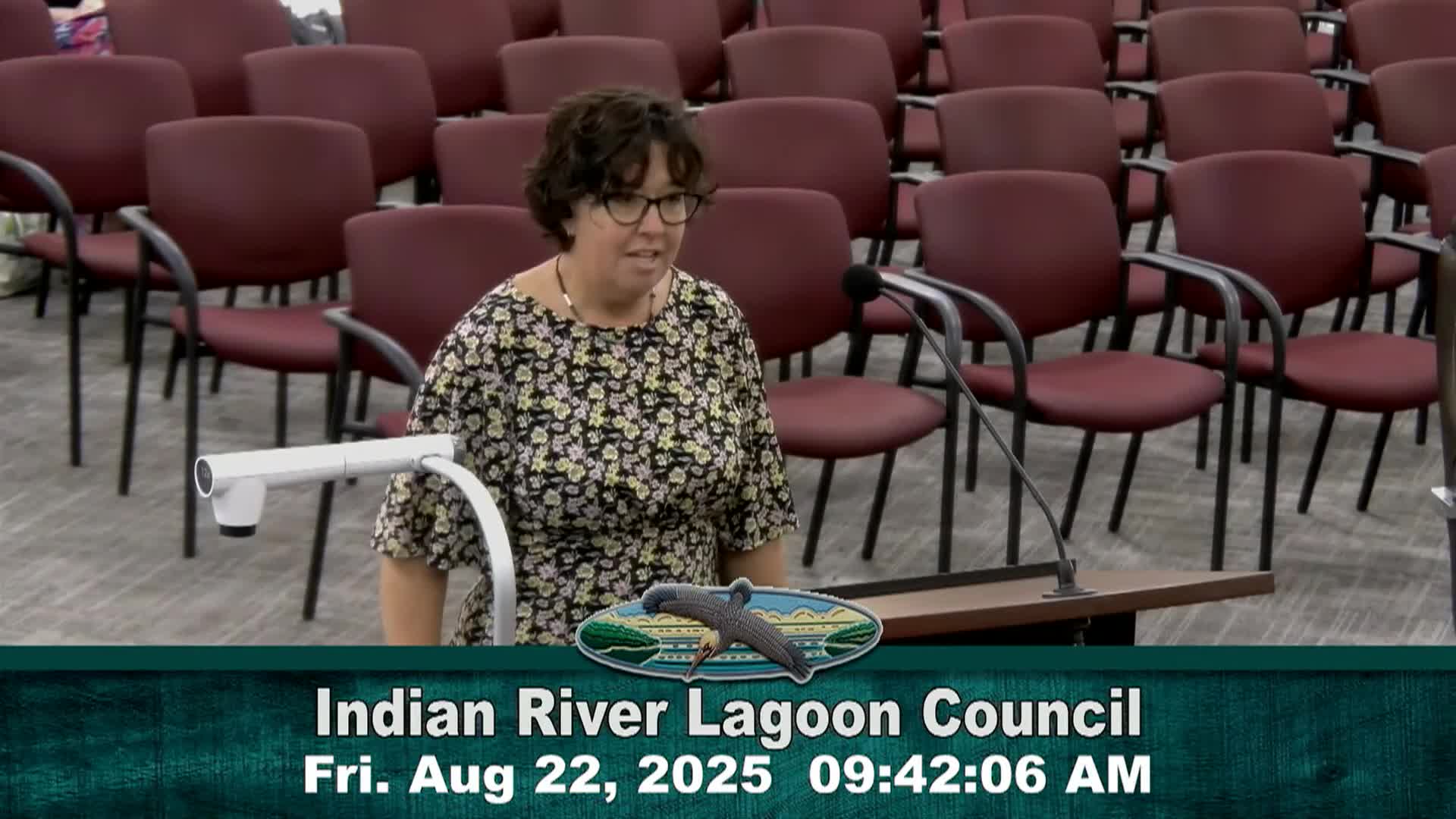Rainfall Patterns Impact Indian River Lagoon's Water Quality and Seagrass Recovery
August 23, 2025 | Sebastian , Indian River County, Florida
This article was created by AI summarizing key points discussed. AI makes mistakes, so for full details and context, please refer to the video of the full meeting. Please report any errors so we can fix them. Report an error »

In the heart of Sebastian, Florida, the Indian River Lagoon Council Board of Directors convened on August 22, 2025, to discuss pressing environmental issues affecting the lagoon's health. The meeting, marked by a focus on rainfall patterns and water quality, revealed a complex interplay of factors influencing the lagoon's ecosystem.
Dr. Parker opened the session with a detailed analysis of recent rainfall trends, noting significant fluctuations across the lagoon. May brought nearly double the rainfall compared to the previous year, while June saw a stark decline. This uneven distribution has raised concerns about runoff and its impact on water quality, particularly in the northern regions where phytoplankton blooms have been reported.
Continuous monitoring stations throughout the lagoon provided critical data on water depth, salinity, and temperature. While water depth remained stable, salinity levels varied significantly across different sites, with Vero Beach showing notable fluctuations due to its proximity to freshwater tributaries. The rising water temperatures, a consequence of the summer heat, have led to decreased dissolved oxygen levels, particularly in the Banana River, raising alarms about potential fish kills.
The meeting also highlighted the ongoing challenges posed by turbidity and phytoplankton blooms. Mosquito Lagoon experienced considerable fluctuations in water clarity, attributed to its shallow depths and sediment types. The presence of blooms, particularly of the species Aureolembra and Pyrodinium bahamense, has compromised water clarity, with Secchi depths dropping below 0.5 meters in some areas.
Seagrass recovery was another focal point, with preliminary data indicating mixed results. While some sites showed a decline in seagrass cover, others, particularly in the southern lagoon, demonstrated resilience and even growth. The council expressed cautious optimism about the diversity of seagrass species returning to certain areas, a positive sign for the lagoon's overall health.
In a notable development, the meeting addressed the emergence of a new calcareous species, previously unseen in the lagoon for over four decades. Its expansion raises questions about its potential impact on seagrass recovery, prompting ongoing monitoring and research.
As the meeting concluded, the council emphasized the importance of continued collaboration and research to address the lagoon's challenges. With plans for expanded studies and monitoring efforts, the board remains committed to safeguarding the Indian River Lagoon's delicate ecosystem for future generations.
Dr. Parker opened the session with a detailed analysis of recent rainfall trends, noting significant fluctuations across the lagoon. May brought nearly double the rainfall compared to the previous year, while June saw a stark decline. This uneven distribution has raised concerns about runoff and its impact on water quality, particularly in the northern regions where phytoplankton blooms have been reported.
Continuous monitoring stations throughout the lagoon provided critical data on water depth, salinity, and temperature. While water depth remained stable, salinity levels varied significantly across different sites, with Vero Beach showing notable fluctuations due to its proximity to freshwater tributaries. The rising water temperatures, a consequence of the summer heat, have led to decreased dissolved oxygen levels, particularly in the Banana River, raising alarms about potential fish kills.
The meeting also highlighted the ongoing challenges posed by turbidity and phytoplankton blooms. Mosquito Lagoon experienced considerable fluctuations in water clarity, attributed to its shallow depths and sediment types. The presence of blooms, particularly of the species Aureolembra and Pyrodinium bahamense, has compromised water clarity, with Secchi depths dropping below 0.5 meters in some areas.
Seagrass recovery was another focal point, with preliminary data indicating mixed results. While some sites showed a decline in seagrass cover, others, particularly in the southern lagoon, demonstrated resilience and even growth. The council expressed cautious optimism about the diversity of seagrass species returning to certain areas, a positive sign for the lagoon's overall health.
In a notable development, the meeting addressed the emergence of a new calcareous species, previously unseen in the lagoon for over four decades. Its expansion raises questions about its potential impact on seagrass recovery, prompting ongoing monitoring and research.
As the meeting concluded, the council emphasized the importance of continued collaboration and research to address the lagoon's challenges. With plans for expanded studies and monitoring efforts, the board remains committed to safeguarding the Indian River Lagoon's delicate ecosystem for future generations.
View full meeting
This article is based on a recent meeting—watch the full video and explore the complete transcript for deeper insights into the discussion.
View full meeting